Green Spaces
Discover the natural biodiversity of Cartagena
- Home /
- The Centre
- Green Spaces
Green Spaces

Dunes, Sandbanks & Beaches
1. Cretan Trefoil
/
1. Lotus creticus
2. European Sea-Rocket
/
2. Cakile maritima
3. Marram Grass
/
3. Ammophila arenaria

Cliffs & Crags
4. Sea Lettuce
/
4. Limonium cossonianum
7. Rock Samphire
/
1. Crithmum maritimum
5. Sea Thrift
/
5. Armeria maritima
6. Sea Aster
/
6. Astericus maritimus
7. Rock Samphire
/
1. Crithmum maritimum

Saline Steppes
8. Siempreviva de Saladar
/
8. Limonium insigne
9. Wavyleaf Sea Lavender
/
9. Limonium sinuatum

Pastures on volcanic soil
14. Looseflower Milkvetch
/
8. Astragallus nitidiflorus
15. Ramose False Brome
/
15. Brachypodium retusum

Thickets and thermophilic bushes
16. Fern Leaf Lavender
/
16. Lavandula multifia
10. Male Rosemary
10. Cistus clusii
13. Jara de Cartagena
13. Cistus heterophylius
17. Jerusalem Sage
17. Phlomis purpurea
11. Mata Turmera
11. Helianthemm almeriense
C. Dwarf Fan Palm
C Chamaerops humilis
18. Cornical
18. Periploca angustifolia
12. Rauhe Zistrose
12. Cistus crispus

Thickets and thermophilic bushes
16. Fern Leaf Lavender
/
16. Lavandula multifia
17. Jerusalem Sage
/
17. Phlomis purpurea
18. Cornical
/
10. Cistus clusii
10. Male Rosemary
/
10. Cistus clusii
11. Mata Turmera
/
11. Helianthemm
12. Rauhe Zistrose
/
12. Cistus crispus
13. Jara de Cartagena
/
13. Cistus heterophylius
C. Dwarf Fan Palm
/
C Chamaerops humilis

Sandarac Forests
T Sandarac tree
T Tetraclinis articulata

Dunes, Sandbanks & Beaches
Coastal dunes and beaches have a critical role in the stability of the coast. However, these scarce and fragile ecosystems are submitted to a strong anthropic pressure that is leading to their progressive disappearance. The main characteristic of the flora found in these areas is its adaptability to high concentrations of salt, lack of fresh water and nutrients, and a highly mobile substrate.
 Characteristics.
Characteristics.
Small creeping plant—it grows horizontally and low to the ground—perfectly adapted to sea sandbanks, with a good tolerance for salinity and, most importantly, to water stress—caused by extreme variations in the amount of water received by the plant throughout the year.
When and where can we find it?
It is perennial, but its beautiful yellow flowers blossom from February to June. It is quite common in dune areas like Calblanque Regional Park and Monte de las Cenizas.
Fun facts.
It is a leguminous plant, i.e. a legume, with a strategy to disperse its seeds: its pods are twisted into a spiral—hence its name in Spanish: “cuernecillo de mar” (sea horn).
Further Research.
http://www.floramu.com/verficha.php?ficha=6 http://www.regmurcia.com/servlet/s.Sl?sit=c,365,m,1309&r=ReP-24878-DETALLE_REPORTAJES
 Characteristics.
Characteristics.
With a maximum height of 40 cm, this annual plant is one of the first to colonise newly formed sand dunes and accumulations of marine algae thanks to its roots, which easily take hold in shifting sands.
When and where can we find it?
We can find it on beaches and dunes at any time of the year. It blossoms all year round, producing violet flowers and a distinctive fruit similar to an arrowhead.
Fun facts. The fruit of the European sea-rocket can be carried away by the ocean currents for weeks before stopping at a beach, where it will germinate and lead to a new plant.
Further Research. http://herbarivirtual.uib.es/cas-uv/especie/3958.html http://www.florasilvestre.es/mediterranea/Cruciferae/Cakile_maritima.htm
 Characteristics. The marram grass is associated with sandbanks. It grows in stems with spikes at the tip, which makes it look like a cereal. It is found in groups.
Characteristics. The marram grass is associated with sandbanks. It grows in stems with spikes at the tip, which makes it look like a cereal. It is found in groups.
When and where can we find it? This greyish-green plant is perennial, barely changing its appearance throughout the year, except for in May, through its flowering period, its spikes become yellowish. It is found on the dune areas around Mar Menor and Calblanque.
Fun facts. It has been widely used to secure dunes due to its powerful rhizome system, with strong underground development.
Further Research. http://www.natureduca.com/blog/flores-ornamentales-barron-ammophila-arenaria-psamma/ http://herbarivirtual.uib.es/cas-ub/especie/3990.html
Cliffs & Crags
Cliffs, crags and coastal caves face special conditions such as high humidity and sun exposure, substrate absence, exposure to sea sprays and strong winds, etc. That is why some plant species have developed adaptations to those particular conditions: adapted stems, great ability to regrow, succulent leaves…
 Characteristics. This dark green plant is perennial and can grow up to 0.8 m high. It is common in coastal crags but also in inland areas, only in soils with high concentrations of salts.
Characteristics. This dark green plant is perennial and can grow up to 0.8 m high. It is common in coastal crags but also in inland areas, only in soils with high concentrations of salts.
When and where can we find it? It is found all year around on the coasts of Cartagena, though it is most beautiful in summer, when it blossoms taking on a white or slightly blueish tone.
Fun facts. It is listed in the Regional Protected Wild Flora Catalogue of the Region of Murcia (Decree 50/2003, BORM no. 131) under category “Of Special Interest”.
Further Research. http://www.floramu.com/verficha.php?ficha=49 http://www.regmurcia.com/servlet/s.Sl?sit=c,365,m,1050&r=ReP-5121-DETALLE_REPORTAJES
 Characteristics. Herbaceous perennial plant about 20 cm high, with deep green leaves, often found in the rocky coastal areas of Cartagena.
Characteristics. Herbaceous perennial plant about 20 cm high, with deep green leaves, often found in the rocky coastal areas of Cartagena.
When and where can we find it? Blossoming from May through the summer, its beautiful and abundant flowers, though much smaller, resemble the carnation flower in shape, with shades ranging from white to lilac.
Fun facts. The sea thrift has a highly appreciated ornamental value, which together with its easy maintenance and low demands on soil and irrigation makes it ideal to cover rockery in gardens.
Further Research. http://fichas.infojardin.com/perennes-anuales/armeria-maritima-cesped-de-espana-gazon.htm http://www.luontoportti.com/suomi/es/kukkakasvit/clavelina-de-mar
 Characteristics. Small perennial plant that grows in crags and sandbanks, leveraging on fissures between rocks. It is a creeping plant—it grows horizontally and low to the ground—with very showy flowers.
Characteristics. Small perennial plant that grows in crags and sandbanks, leveraging on fissures between rocks. It is a creeping plant—it grows horizontally and low to the ground—with very showy flowers.
When and where can we find it? It reaches its most magnificent expression in the flowering season, which begins in May and extends well into the summer, giving rise to abundant yellow flowers similar to daisies. It is common all along the coast of Cartagena, but especially abundant in the dunes of Calblanque Regional Park and Marina del Carmolí.
Fun facts. It is ideal for use as an embellishment in gardens because it requires little maintenance and care, while being very showy and decorative. However, its use is not yet widespread.
Further Research. http://www.floramu.com/verficha.php?ficha=13 http://www.regmurcia.com/servlet/s.Sl?sit=c,365,m,1050&r=ReP-6812-DETALLE_REPORTAJES

Characteristics.
This small marine shrub is perennial, reaches up to 50 cm in height and is easily distinguished by its thick stems of an intense green colour. Its habitat is very specific: it grows in rock fissures and stony ground on the seafront, highly exposed to saline aerosols.
When and where can we find it? It is found all year around, especially in the coves of Calblanque Regional Park. It blooms in late summer, until October, with small clustered yellowish flowers on slender stems.
Fun facts. It is an edible plant, with a strong flavour reminiscent of celery and asparagus and a salty touch. Its historical references go back to the time of ancient Greece and it has been traditionally used in pickled form as an anti-scorbutic and diuretic. Additionally, its essential oil is used in perfumes.
Further Research. http://www.floramu.com/verficha.php?ficha=11 http://www.regmurcia.com/servlet/s.Sl?sit=c,365,m,1050&r=ReP-8716-DETALLE_REPORTAJES
Saline Steppes
Saline steppes are found on the margins of salt marshes, temporary water flows, watercourses, coastal wetlands, etc., as well as in the elevated areas above these zones, so they are exposed to less humidity. This lower humidity, together with intense periods of drought in summer and the high salinity of the substrate (halophilic vegetation), leads to a specific type of vegetation.
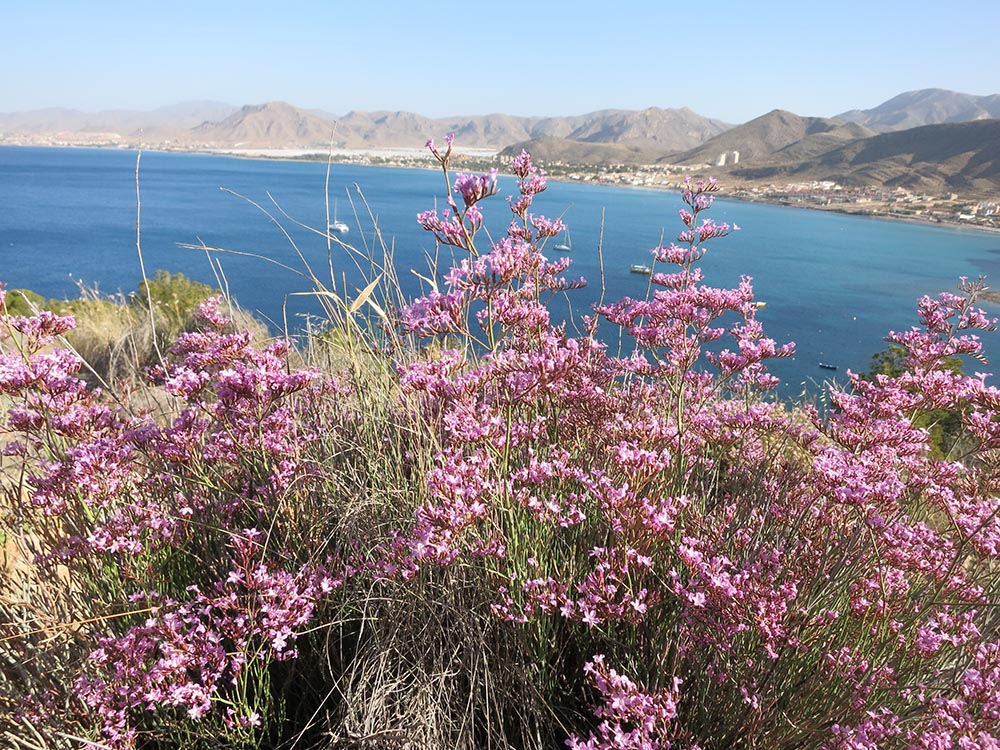 Characteristics.
Characteristics.
Perennial plant, unique to the saline soils of Murcia and Almería, which develops on branched and articulated stems of a deep green colour that can reach up to 90 cm in height.
When and where can we find it?
Especially common in La Muela National Park and Cabo Tiñoso, this plant is easily identifiable by the appearance of its stems. Its showy pink flowers are spectacular, blossoming from the end of winter through June.
Fun facts.
It is typical to collect them in the time of flowering and put them in vases, after applying hairspray to prevent their flowers from falling quickly. In spite of its great ornamental potential, it is rarely used.
Further Research. http://www.ecured.cu/Limonium_insigne http://www.florasilvestre.es/mediterranea/index.htm
 Characteristics.
Characteristics.
Perennial plant which develops on branched and articulated stems of a deep green colour that can reach up to 40 cm in height.
When and where can we find it?
Common in salt marshes and visible all year around, this plant is easily identifiable from the appearance of its stems. Its showy pink flowers are spectacular, blossoming from the end of winter through June.
Fun facts.
It is commonly cultivated to produce dry, cut and potted flowers.
Further Research.
http://florasilvestredemurcia.blogspot.com.es/2015/12/flora-Murcia-limonium-sinuatum.html http://www.infoagro.com/flores/plantas_ornamentales/limonium.htm
Pastures on volcanic soil
Cliffs, crags and coastal caves face special phenomena like high humidity and sun exposure, substrate absence, exposure to sea sprays and strong winds, etc. That is why some plant species have developed adaptations to those particular conditions: adapted stems, great ability to regrow, succulent leaves…
 Characteristics.
Characteristics.
Small leguminous plant endemic to the municipality of Cartagena, which was believed to be extinct until rediscovered in 2004. It is one of the most important protected species in the Region of Murcia.
When and where can we find it?
Currently there is only one natural population which is located in Cabezos del Pericón (Cartagena). It is perennial, blossoming into yellowish small flowers from March to late April or early May.
Fun facts.
In the west of Cartagena, the ECUGA (Territory Custody Entity for the Conservation of the Looseflower Milkvetch), together with the local and regional Administration and the Polytechnic University of Cartagena, is doing a great job in enhancing the value of this species and disseminating knowledge about it through conservation programmes, reintroduction, nursery management, research development and environmental education projects.
Learn more. http://www.regmurcia.com/servlet/s.Sl?sit=c,365,m,1309&r=ReP-8597-DETALLE_REPORTAJES https://custodiadelgarbancillo.es/ http://www.lifegarbancillo.es/ http://www.murciaenclaveambiental.es/segundo-trimestre-2013.html?idRe=184
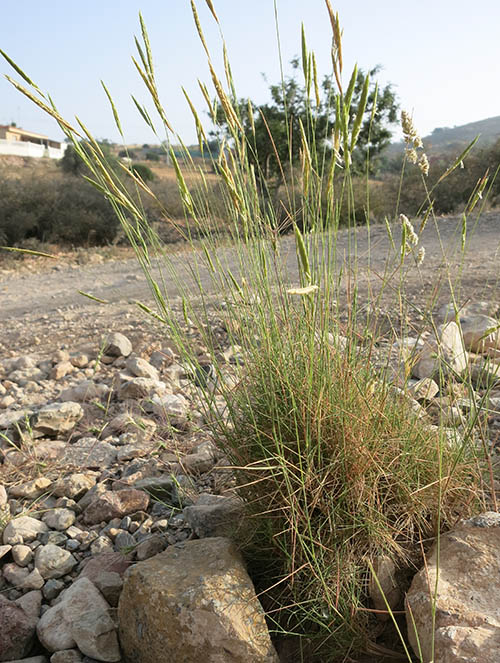 Characteristics.
Characteristics.
Perennial plant that grows on stems up to 60 cm high with spikes at the tip, forming grasslands.
When and where can we find it?
It is very frequent in the Mediterranean scrubland as a whole, usually growing in pine forests. They form meadows that are habitats of community interest. Since its flowers are not very obvious, it maintains practically the same appearance throughout the year.
Fun facts.
It is used for certain medicinal purposes, but most of all in gardening to protect and secure slopes in stony soils. It could be a strong candidate to replace the typical “grass” esplanades in public gardens, as a more ecological alternative that requires less maintenance. Unfortunately, little research has been done on this option.
Learn more.
http://www.regmurcia.com/servlet/s.Sl?sit=c,365,m,1050&r=ReP-27525-DETALLE_REPORTAJES
Thickets and thermophilic bushes
As its name suggests, these bushes are typical of hot, rather dry climates. Specifically, the semi-desert conditions in our area favour the proliferation of endemic species and plants typical of North Africa. It is a very diverse ecosystem in terms of plant species, which are determined by the scarcity of water and the relative salinity of the soil.
 Characteristics.
Characteristics.
Perennial shrub typical of Mediterranean scrublands and grasslands, growing on slopes, bottoms of watercourses, roadsides, etc. It is easily recognised by its widely divided leaves, by the hairy appearance of the stems and leaves that gives it a greyish-green colour, and by the spikes at the end of the stems.
When and where can we find it?
It is very frequent in the Mediterranean scrubland as a whole, blossoming from October to July. It is easily distinguished by the intense indigo-purple colour of the flowers on its spikes. It has an intense and characteristic smell.
Fun facts.
Lavenders have traditionally been used as ornamental plants, to obtain essential oils, for medicinal and flavouring purposes, and as a condiment.
Learn more.
http://floressilvestresdelmediterraneo.blogspot.com.es/2012/11/labiatae-lavandula-multifida.html
 Characteristics.
Characteristics.
Shrubby plant with rough leaves covered in hair that gives it its characteristic colour—almost whitish greyish-green. It can reach up to 2 m in height.
When and where can we find it?
Mostly present in limestone soils, it is very frequent in the Mediterranean scrubland as a whole. Its whitish-pink flowers can be seen from March to June.
Fun facts.
It is often used in gardening to add volume to flowerbeds, due to its large size.
Learn more.
http://www.floramu.com/verficha.php?ficha=43
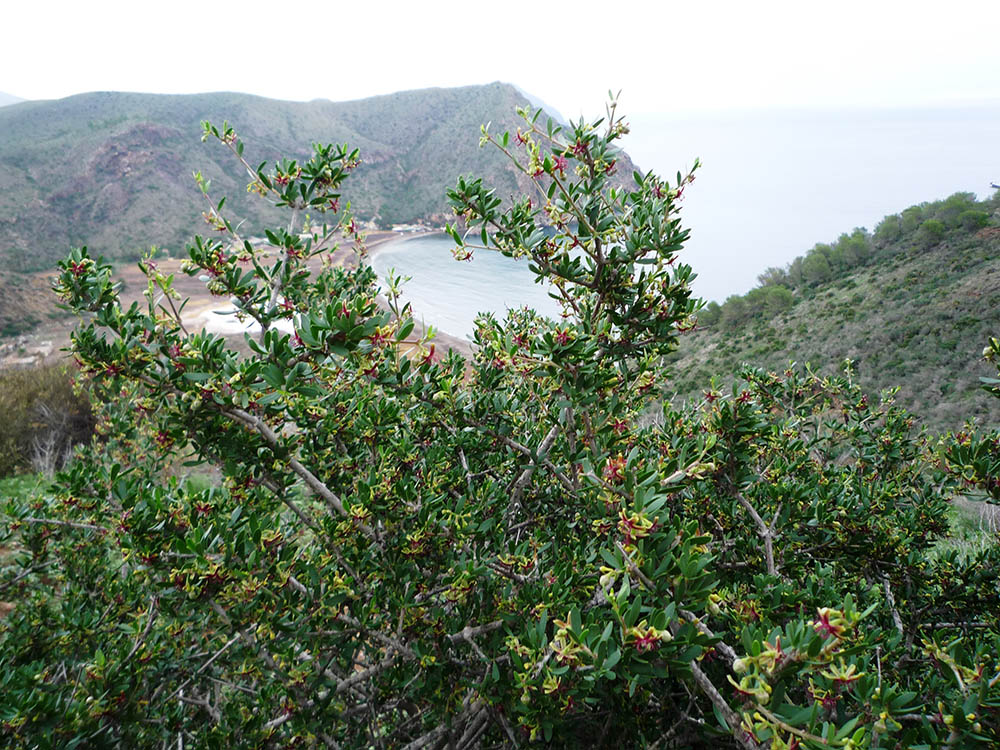 Characteristics.
Characteristics.
Perennial shrub up to 1.5 m high, with thick, glossy green leaves, dominant in thickets existing on stony ground in very sunny rocky areas.
When and where can we find it?
It is very common in bushes near the coast that are highly exposed to sunlight. Its flowers, which are visible practically for as long as the plant remains green—from October to June—, are star-shaped with the inner side coloured in white, and brown or dark purple. Its fruits, easily recognizable by their horn-like shape, can be found open and full of seeds starting in April.
Fun facts.
It is used for medicinal purposes, as cattle feed and even as fuel. It is said that children used to eat its flowers as candy.
Learn more.
http://www.floramu.com/verficha.php?ficha=41 http://www.regmurcia.com/servlet/s.Sl?sit=c,365,m,1308&r=ReP-8219-DETALLE_REPORTAJES
 Characteristics.
Characteristics.
Perennial shrub up to 1 m high, with brownish green stems and an abundant inflorescence of showy white flowers.
When and where can we find it?
Typical of Mediterranean scrublands, it is usually found on dry, stony slopes, in spaces with presence of esparto, rosemary, thyme, pines, etc. Its flowers, blossoming in spring, are very showy.
Fun facts.
It is known as “male rosemary” because outside the flowering season it is very similar to rosemary, unlike which it is odourless.
Learn more.
http://www.regmurcia.com/servlet/s.Sl?sit=a,0,c,365,m,1308&r=ReP-29342-DETALLE_REPORTAJES
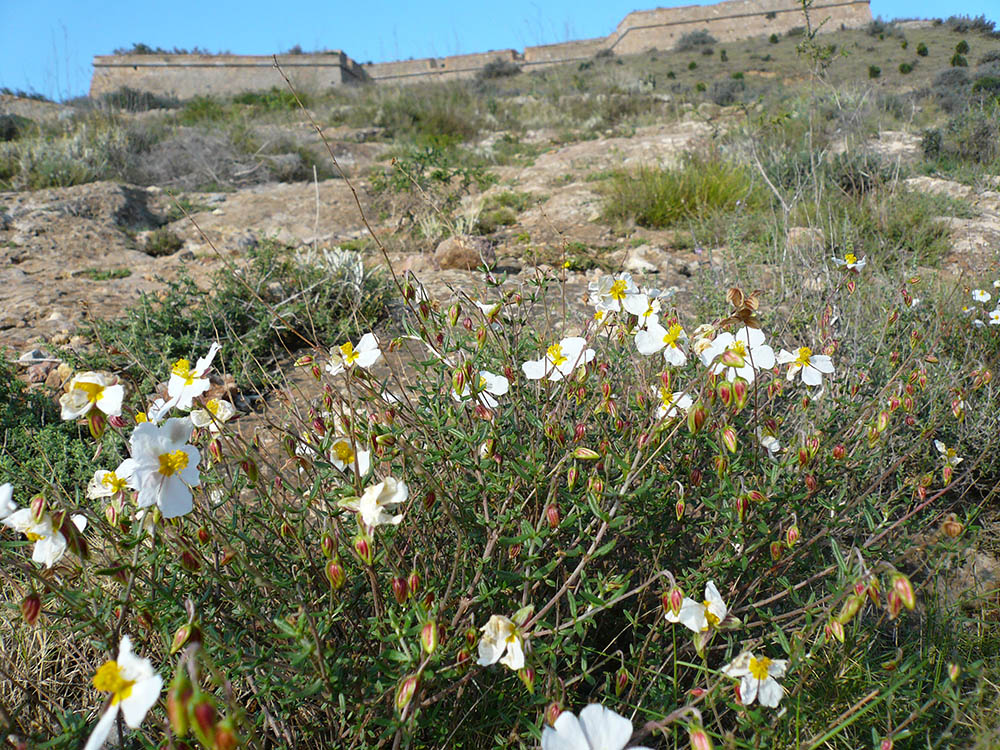 Characteristics.
Characteristics.
Perennial shrub up to 60 cm high, with highly branched green stems and an abundant inflorescence of showy white flowers.
When and where can we find it?
Typical of Mediterranean scrublands, it is usually found on dry, stony slopes, in spaces with presence of esparto, rosemary, thyme, pines, etc. Its flowers, blossoming in spring, are very showy.
Fun facts.
Its presence is linked to that of turma (Terfezia claveryi), also known as “desert truffle”, an underground fungus of culinary interest traditionally used as livestock feed.
Learn more.
http://floressilvestresdelmediterraneo.blogspot.com.es/2015/01/cistaceae-helianthemum-almeriense.html
http://www.almerinatura.com/joyas/helianthemum-almeriense.html
 Characteristics.
Characteristics.
Perennial shrub up to 60 cm high, with green stems, hairy green leaves and an abundant inflorescence of showy pink flowers.
When and where can we find it?
Typical of Mediterranean scrublands, it is usually found in spaces with presence of cork trees, holmoaks, pines, heathers, etc. It may arise on stony soils. Its flowers, blossoming in spring, are very showy.
Fun facts.
Some rockrose species produce on their leaves oily substances that give them a shiny appearance and are believed to protect them from predators.
Learn more.
http://bdb.cma.gva.es/ficha.asp?id=14492
 Characteristics.
Characteristics.
Perennial shrub up to 1 m high, with green stems, green leaves and an abundant inflorescence of showy purplish-pink flowers.
When and where can we find it?
As an endemic species of the municipality of Cartagena, it can be found in Peña del Águila. Its flowers, blossoming in spring, are very showy.
Fun facts.
It is listed in the Regional Protected Wild Flora Catalogue of the Region of Murcia under category “Endangered Species”, since its survival is seriously threatened.
Learn more.
http://www.regmurcia.com/servlet/s.Sl?sit=c,365,m,1050&r=ReP-14268-DETALLE_REPORTAJES
 Characteristics.
Characteristics.
Perennial shrub similar in appearance to a small palm tree, usually characterised by a short trunk and a stunted growth.
When and where can we find it?
Species typical of Mediterranean scrublands, generally growing on sunny gentle slopes. One of the best places to observe large fan palm groves is Calblanque Regional Park.
Fun facts.
Young stem nodes are used in cooking. However, their collection and preparation process is laborious and causes great damage to the plant. By contrast, its fruit, known in Cartagena as “fox date”, is not eaten. It has a highly appreciated ornamental value.
Learn more.
http://www.floramu.com/verficha.php?ficha=10 http://www.regmurcia.com/servlet/s.Sl?sit=c,365,m,1050&r=ReP-5130-DETALLE_REPORTAJES
Sandarac Forests
The sandarac (Tetraclinis articulata) is more common in North Africa, with a few populations in the southeast of Spain, specifically in the mountains of Cartagena. These forests thrive in the driest places in the Peninsula, with precipitation ranging from 300 to 400 mm, mainly growing on sunny slopes (it is very thermophilic).
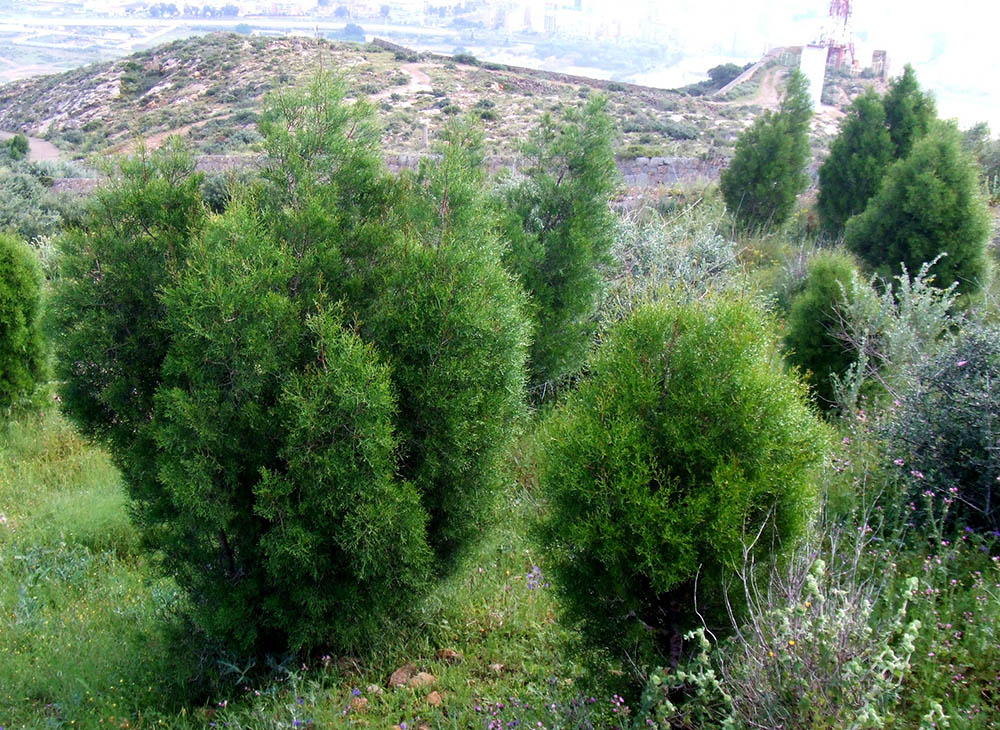 Characteristics.
Characteristics.
Small tree, usually between 3 and 5 meters high, with a dark brown trunk and ascending branches forming a conical crown.
When and where can we find it?
It is an endemic Ibero-African species which, in Cartagena, can be mainly found in the area of Monte de las Cenizas.
Fun facts.
Its resin, called “sandarac” as well, is used to make varnish and lacquer, and also for medicinal purposes. There are historical references to the use of its wood in decoration.
Learn more.
http://www.floramu.com/verficha.php?ficha=54 http://www.regmurcia.com/servlet/s.Sl?sit=a,0,c,365,m,1307&r=ReP-29312-DETALLE_REPORTAJES http://www.floraprotegida.es/flora-vulnerable.php/Tetraclinis-articulata-112




